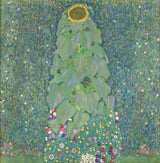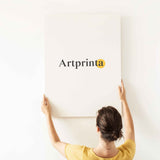Gustav Klimt, 1908 - Sunflower - fine art print
Tax included. Shipping calculated at checkout.
Additional information from Belvedere (© - Belvedere - Belvedere)
In the immediate vicinity of by Gustav Klimt and family Flöge in the summers of 1900 am Attersee was the farm of Anton Mayr, to a pretty cottage garden with sunflowers belonged until 1907 inhabited Bräuhofs in Litzlberg. For an essay on clothes models from the fashion house of the Sisters Flöge which he photographed for the magazine German art and decoration, was Klimt in the summer of 1906 Emilie Flöge in this garden posing in reform dresses. In fact verbildlichte Klimt cottage garden in Litzlberg and a single sunflower. "There are going new things in nature," the art critic Ludwig Hevesi, remarked "once a Klimt in occurs." In fact begins "his", Klimt, natural from now on a strange life of its own to develop. Herein lies a major difference to the sunflower paintings of Vincent van Gogh, who describes the reactions of the flowers on very specific conditions that may well suit his own mental perception. Klimt other hand, the natural life of its own. They developed a completely new, hierarchical classification system, shielding themselves from all outside influences. Not without reason one thinks of human characteristics and remembers a saying Peter Altenberg for his landscape paintings: "They have been raised to their own romantic peak points." Ludwig Hevesi noted in this context that Klimt's Sunflower "like a fairy love" appearing "whose greenish gray garment passionate shudder down flows". With the knowledge of the mentioned fashion shoots of sunflower can on a metaphorical level, the figure certainly be associated with Emilie Flöge. The self-contained representation of the beautiful but lonely flower then correspond to the never-defined life relationship between her and Klimt. Yet she's lonely, locked, and is admired by all. A year later, the two lovers (Kiss) Klimt's desire is fulfilled in the formally very similar monumental icon - even if only in an imaginary world of images. [Alfred Weidinger, 3/2012]
Structured artwork details
| Piece of art title: | "Sunflower" |
| Categorization: | painting |
| Art classification: | modern art |
| Period: | 20th century |
| Artpiece year: | 1908 |
| Age of artwork: | over 110 years old |
| Medium of original artwork: | oil on canvas |
| Size of the original artwork: | 110 x 110 cm - frame: 114,5 x 114,5 x 6 cm showcases Dimensions: 146 cm × 146 × 14 |
| Signature on artpiece: | signed lower right: GUSTAV / KLIMT |
| Museum / collection: | Belvedere |
| Place of the museum: | Vienna, Austria |
| Website of the museum: | www.belvedere.at |
| Artwork license: | public domain |
| Courtesy of: | © Belvedere, Vienna, inventory number: 10500 |
| Creditline of artwork: | legat Peter Parzer, Vienna in 2012 |
Artist information table
| Artist: | Gustav Klimt |
| Also known as: | Klimt, Klimt Gustav, g. klimt, gust. klimt, Gustav Klimt, Klimt Gustave, klimt g., Gustave Klimt, קלימט גוסטב, クリムト, klimt gustav |
| Gender of the artist: | male |
| Nationality: | Austrian |
| Jobs of the artist: | painter |
| Country of origin: | Austria |
| Classification: | modern artist |
| Art styles: | Art Nouveau |
| Lifespan: | 56 years |
| Birth year: | 1862 |
| Place of birth: | Vienna state, Austria |
| Died in the year: | 1918 |
| Deceased in (place): | Vienna, Vienna state, Austria |
About this product
| Product type: | fine art reproduction |
| Method of reproduction: | digital reproduction |
| Manufaturing technique: | digital printing (UV direct print) |
| Provenance: | Germany |
| Stock type: | on demand |
| Intended product usage: | wall picture, art print gallery |
| Orientation of the artwork: | square alignment |
| Image ratio: | length to width 1 : 1 |
| Meaning of image aspect ratio: | the length is equal to the width |
| Fabric variants: | metal print (aluminium dibond), poster print (canvas paper), canvas print, acrylic glass print (with real glass coating) |
| Canvas print (canvas on stretcher frame) sizes: | 20x20cm - 8x8", 30x30cm - 12x12", 50x50cm - 20x20", 70x70cm - 28x28", 100x100cm - 39x39", 150x150cm - 59x59", 180x180cm - 71x71" |
| Acrylic glass print (with real glass coating) variants: | 20x20cm - 8x8", 30x30cm - 12x12", 50x50cm - 20x20", 70x70cm - 28x28", 100x100cm - 39x39", 150x150cm - 59x59", 180x180cm - 71x71" |
| Poster print (canvas paper): | 30x30cm - 12x12", 50x50cm - 20x20", 70x70cm - 28x28", 100x100cm - 39x39" |
| Aluminium print size variants: | 20x20cm - 8x8", 30x30cm - 12x12", 50x50cm - 20x20", 70x70cm - 28x28", 100x100cm - 39x39" |
| Picture frame: | not included |
Get your material
The product dropdown menu ofers you the possibility to choose your individual material and size. We allow yout to choose among the following variants:
- Canvas: The canvas print, not to be mistaken with a real artwork painted on a canvas, is a digital image applied directly on canvas. It makes a plastic effect of three dimensionality. Furthermore, a canvas makes a attractive and positive appearance. A canvas of this artwork will let you turn your individual into a large size work of art. Canvas Prints have the advantage of being low in weight. That means, it is easy and straightforward to hang up the Canvas print without any wall-mounts. Therefore, canvas prints are suited for any type of wall.
- Acrylic glass print (with real glass coating): A glossy acrylic glass print, which is sometimes denoted as a an art print on plexiglass, changes the original artwork into décor. Moreover, the acrylic fine art print is a distinct alternative option to canvas and dibond fine art replicas. Your own version of the artwork will be printed with modern UV printing machines.
- Poster on canvas material: A poster print is a printed cotton canvas paper with a slight structure on the surface. Please note, that depending on the absolute size of the poster print we add a white margin of something between 2-6 cm around the work of art, which facilitates the framing.
- Aluminium dibond (metal print): Aluminium Dibond prints are prints on metal with an outstanding effect of depth. A non-reflective surface make a contemporary impression. The bright parts of the artwork shimmer with a silk gloss, however without any glow. The colors are bright and vivid in the highest definition, details of the print appear very clear, and you can feel a matte appearance of the product.
Details of this article
This masterpiece was painted by the art nouveau master Gustav Klimt in 1908. The original was made with the size: 110 x 110 cm - frame: 114,5 x 114,5 x 6 cm showcases Dimensions: 146 cm × 146 × 14 and was painted with the technique of oil on canvas. Signed lower right: GUSTAV / KLIMT is the artwork's inscription. Nowadays, the artpiece can be viewed in in the collection of Belvedere. This artwork, which is part of the public domain is being provided with courtesy of © Belvedere, Vienna, inventory number: 10500. Additionally, the artwork has the following creditline: legat Peter Parzer, Vienna in 2012. On top of that, alignment is in square format and has a ratio of 1 : 1, which means that the length is equal to the width. The painter Gustav Klimt was a European artist, whose art style was primarily Art Nouveau. The Austrian artist was born in 1862 in Vienna state, Austria and deceased at the age of 56 in 1918 in Vienna, Vienna state, Austria.
Legal note: We try everythig possible to depict the products as accurate as possible and to showcase them visually on the different product detail pages. Nonetheless, the pigments of the print materials and the printing may differ somehwat from the presentation on the monitor. Depending on the settings of your screen and the nature of the surface, not all colors can be printed one hundret percent realistically. In view of the fact that all art reproductions are processed and printed manually, there may also be minor discrepancies in the exact position and the size of the motif.
This text is copyrighted ©, www.artprinta.com (Artprinta)














